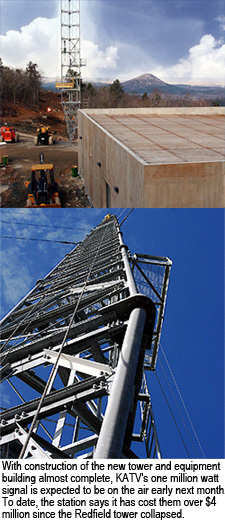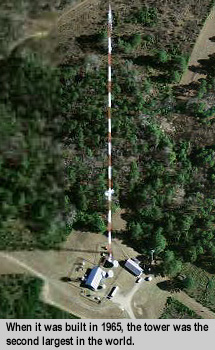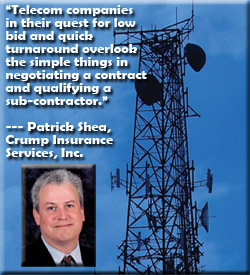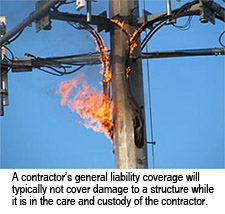Quarter million dollar guy wire change-out could result in multi million dollar judgment
January 16, 2009 - Structural Systems, Inc. of McLean, Va., was performing a professionally challenging, but routine guy wire change-out on January 11, 2008 for KATV's 2,000-foot guyed tower in Redfield, Ar. when the structure suddenly collapsed. KATV's 2,000-foot guyed tower in Redfield, Ar. when the structure suddenly collapsed.
One crew member received minor injuries when he was reportedly struck by a flailing guy wire, but he refused medical treatment.
The almost half mile of white and red twisted steel has long been removed from the site.
Stainless LLC of North Wales, Pa. enthusiastically accepted a purchase order for a new 1,200-foot tall replacement tower on Shinall Mountain and Tower King ll of Cedar Hill, Tx. welcomed the sudden erection opportunity.
After the collapse, the Little Rock station was able to establish a feed to restore its signal to the portion of its audience that obtains programming by satellite and cable.
Although logistical problems for rebuilding seemed overwhelming at times, station officials are beaming over their new tower and state of the art broadcast facility that is replacing the 43-year-old outdated corrugated roof building they were operating out of in Redfield.
They expect the new facility to be operational in early February. (Pictures at right courtesy KATV)
However, nothing good came out of the structural failure for OneBeacon America Insurance Co. of Boston who insured the tower, and has paid KATV and its parent company $4 million. The insurer is now suing SST, citing multiple counts of negligence, breach of contract and fraud. OneBeacon America has not disclosed how much in damages it's seeking.
Jurors may not see overwhelming evidence
OneBeacon America's Dallas and Little Rock trial lawyers might have to rely upon the dynamics of persuasion, in addition to explaining engineering dynamics. The jury trial request was filed December 22 in the U.S. District Court for the Eastern District of Arkansas.
The court case might also serve as a primer for writing proper contracts and understanding general liability insurance coverage, which may not cover SST should they lose.
During 2006, SST performed an engineering evaluation of the KATV tower and made recommendations, which included replacing top guy cables at levels 8 and 9 of the 9-foot face Dresser Industries structure.
Kaveh Mehrnama, P.E., Vice President, Engineering of SST, said that the guy wire replacement was necessary to reduce the level of overstress.
"It was in the interest of improving the present condition of the tower," Mehrnama explained.
A representative of KATV said that structural improvements and new equipment were added to the tower throughout the past years since it was built in 1965.
Breach of contract alleged
The complaint alleges, among other charges, that SST breached its contract for failing to provide engineering oversight of its guy cable replacement services and safely supervise its workers.
According to Mehrnama, who has 24-years of experience with SST and has developed a specialized computer structural analysis program for guyed towers, the company's President, Fred W. Purdy, is a civil and structural engineer with over 40 years of experience and was on the site viewing the structure with a transit when the tower collapsed.
Although the plaintiff's suit frequently refers to a contract, jurors will only be able to view a two page purchase order from SST for the $250,000 project.
KATV did not provide any specifications for insurance coverage requirements, but relied upon what SST offered in their mostly boiler plate proposal.
"Generally, we have a proposal that is sent to the customer and that becomes the contract," Mehrnama said.
He said that if OneBeacon America should get a judgment he was not sure if SST's $10 million comprehensive liability umbrella coverage would cover the amount.
"We can only hope that they will," said Mehrnama.
Insurance coverage might not be available
Patrick Shea of Crump Insurance Services, Inc., a leading telecom insurer, says that many contractors and tower owners misunderstand what general liability insurance covers.
"In a tower collapse such as this there are those that would assume that general liability would cover the claim, however, it only covers bodily injury and/or property damage to third parties only and it is not intended to cover damages to first parties as this case is."
"If this tower collapse caused damage to an adjacent building or house or to a bystander that was not an employee working on the jobsite, general liability coverage would apply," said Shea, stating that it appears that OneBeacon America responded to KATV's loss under their property insurance coverage since there was apparently insufficient coverage provided by the contractor.
Builders risk insurance or an installation floater form cover losses that occur during the construction phase of projects, Shea said.
"This is a common requirement for sub-contractors when working for general contractors on all types of projects in the US. For some reason, broadcasters have overlooked these requirements both in this situation and others over the past few years."
"Risk managers and attorneys fall head over heals in requiring all types of endorsements, additional limits of liability, and coverage enhancements that are in many cases meaningless in a claim situation like this."
"Telecom companies in their quest for low bid and quick turnaround overlook the simple things in negotiating a contract and qualifying a sub-contractor. In this case, the lack of a contract and the apparent lack of proper insurance makes a catastrophic loss much worse and more expensive with litigation and reputation and the time it will take to settle the claim," Shea said.
SST's previous tower failure was covered
In National Union Fire Ins. Co. of Pittsburgh v Structural Sys. Technology, Inc., three employees of SST were killed when a 2,000-foot tower collapsed in Mo. in 1988.
The court interpreted a commercial general liability policy and products-completed operation policy for the general contractor. SST's insurance carrier denied coverage, which placed the station at risk for having a large part of its business interruption damages uninsured. The owner was named in the suit and argued in favor of coverage. The court found coverage to exist. operation policy for the general contractor. SST's insurance carrier denied coverage, which placed the station at risk for having a large part of its business interruption damages uninsured. The owner was named in the suit and argued in favor of coverage. The court found coverage to exist.
The tower collapsed due to defects in prefabricated hog rods. SST argued that the manufacturer and supplier of the rod was a subcontractor so as to fall within the exception to the "your work" exclusion of its CGL policy.
The court reviewed the contract between the insured and the supplier, which required it to provide, fabricate, galvanize, and deliver to the site all materials per certain design and manufacturing specifications.
The court held that since the insured contracted with the supplier to fabricate specially designed steel rods for the broadcast tower, the exception to the exclusion applied, adopting a ruling favorable to SST.
In terms of defective work, there is little distinction between a subcontractor and a supplier under traditional construction law.
The SST ruling is one of the most leading cases on the "your work"
exclusion of the CGL policy.
|
Temporary guy failure disputed
Press reports said that a temporary guy cable failure could have resulted in the structure's collapse, however, Mehrnama said their temporary guy did not fail, and he was not sure as to why the tower came down.
"We have a special investigator working on it and he hasn't issued his report yet," said Mehrnama.
Last April at a PBS Technology Conference, Thomas Silliman, P.E., President and CEO of Electronics Research, Inc., discussed the Redfield and seven other tower failures that he and Ernie Jones had investigated.
Silliman said that the tower leg connections contained only four ¾-inch bolts and the legs were weak in tension. He noted that the wires were being pulled with a winch and the winch was attached to wires with Crosby clamps.
The wire may have slipped, according to Silliman, and the winch may have moved allowing the Crosby clamps to release the wire.
The tower top then moved off center resulting in an increased moment load on the structure, his report notes, and the moment load put leg connections in tension resulting in their failure.
Insurer to use negligence doctrine
OneBeacon America's additional cause of action against SST for negligence is the long recognized doctrine of "res ipsa loquitur," Latin for "the thing speaks for itself."
It is a theory whereby negligence can be inferred by the mere fact the tower failure happened and that absent someone being negligent or at fault, the Redfield collapse
would not have happened.
The key element that will be argued is that SST had exclusive control of the KATV tower and that the event would not ordinarily have happened if reasonable care had been used.
In 1973 a 70-foot radio tower collapsed in Mo. and the designer was alleged to be negligent. The court held that the doctrine of res ipsa loquitur applied because the falling of an antenna tower is an unusual occurrence and does not ordinarily happen in the absence of negligence.
It is acknowledged that a contractor who is paid to render services to a tower owner is subject to liability for any physical harm resulting from the contractor's failure to exercise reasonable care if the tower owner suffered harm because of reliance upon the contractor.
Every year there are occasions when a contractor has set a monopole on fire while retrofitting the structure by negligent welding of transmission line portholes or reinforcement systems.
Although commercial general liability might pay for any damage that occurred near the site, such as personal vehicle or utility line damage, the structure and the tenants' collocation equipment would typically not be covered.
|